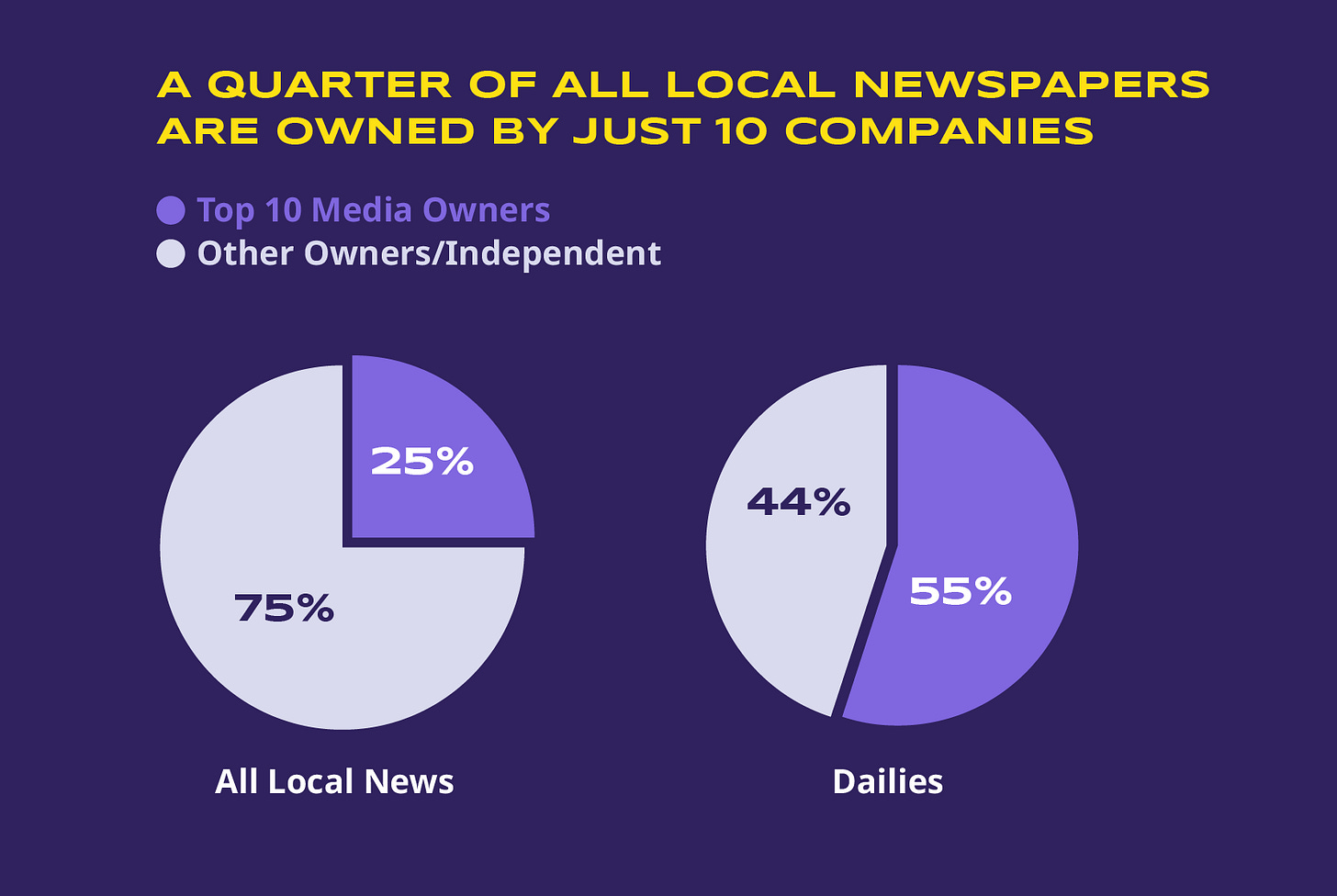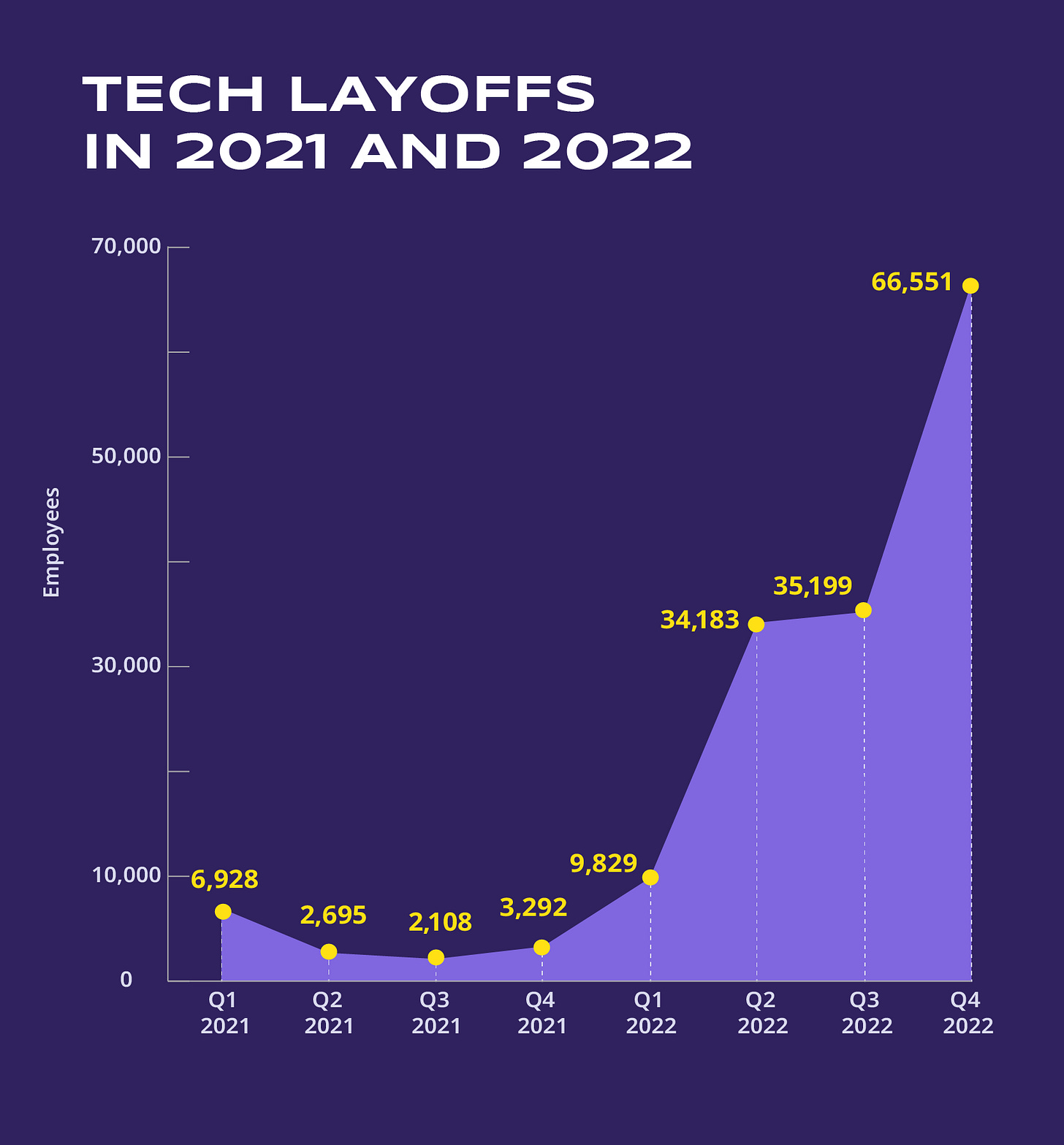What's Next, Now: December 2022
This month, our crystal ball predicts more layoffs as the economy braces for 2023, a killing blow for crypto, and increasing volatility in energy prices.
In the era of shrinking newsrooms, media layoffs during a recession are not uncommon. But some analysts are sounding the alarm that this recession could have a markedly different impact on the American media landscape.
Investment firms and large media companies looking to maximize profits own a far larger share of newspapers in 2022 than in previous recessions. These firms had already cut staff and resources to bare bones when the latest economic headwinds began. Now, all that’s left is to shutter local outlets altogether — leaving more than 70 million Americans in news deserts, without access to local coverage.
When the first round of news media job cuts was announced this year, the U.S. had already lost one-fourth of the newspapers it had in 2005. Now, according to Axios, nearly 1,100 news media jobs have been cut in 2022. In just the last month, the looming recession has already wreaked havoc on publications across the country:
Protocol, a tech news startup founded by the former owner of Politico, is closing its doors.
Morning Brew is losing 14% of its staff.
For Buzzfeed, it’s 12%.
At CNN, the outlet is canceling all original Headline News programming and laying off hundreds of people.
Gannett, the largest local newspaper chain in the U.S., laid off an additional 6% of staff, the latest in a series of repeated cuts for the giant.
Even The Washington Post isn’t immune, shuttering its Sunday magazine and laying off up to 250 employees.
We’re already beginning to see the fallout from understaffed newsrooms as misinformation slips through — even at major media outlets. In November, one instance of erroneous reporting had potentially significant geopolitical consequences when the AP mistakenly reported that a Russian missile had struck Poland.
Stretched newsrooms are being asked to cover more topics with less resources. For brands, that means it’s becoming increasingly difficult to break through with earned media coverage.
At the same time, the number of nonprofit newsrooms has more than doubled in five years. Smaller local news startups are cropping up in markets across the country. As the industry becomes even more fragmented in the years ahead, the burden will fall on consumers and brands to validate news for themselves.
While streaming services have completed their takeover of television, the movie industry is still at a crossroads. Big media brands are continuing to prioritize streaming, but movie theaters aren’t ready to admit defeat just yet.
Despite the Academy’s insistence that a film have a theatrical release in order to qualify for the Oscars, streaming services are seeking workarounds to keep their content contained to their own platforms. For its release of the “Knives Out” sequel “Glass Onion," Netflix restricted the movie’s theatrical run to just one week before pulling it out of theaters and onto its platform. Disney is also prioritizing streaming as it continues to bomb at the box office.
But there’s still reason for hope for theaters — “Top Gun,” this year’s biggest box office success story, took another run at the silver screen with a re-release this month. And “Avatar,” the highest-grossing movie of all time, made its return to theaters this month with a pricey, three-hour long sequel, which will run through the holiday season. For some movie industry experts, the “Avatar” release signals the rebirth of real movies — those made for the theater.
The future of the movie theater lies in the hands of Gen Z, and they’re not ready to give up yet. In a recent survey, 94% of Gen Z respondents named going to movie theaters as a favorite way to spend time. But for young audiences, not all movies are fit for the silver screen — 91% are more likely to go to the theater for a film that is made for a big screen, with surround sound and a receptive audience.

The streaming vs. theatrical debate hasn’t really settled. While some are declaring the triumphant return of movie theaters post-pandemic, others are still calling for the death of theaters and the reign of streaming. But it’s important to be able to separate fads from real trends. While some brands will want to lean one way or the other, it’s also possible to get the best of both worlds (for now). Avoid one-size-fits-all content and speak the language of the platform, curating for your individual audiences.
Following months of turmoil in the markets, the crypto community’s bubble is finally bursting — and FTX’s complete collapse last month poured gasoline on the financial fire. After FTX spooked investors (many of whom will never see their money again), other crypto exchanges, including Binance, BlockFi, Voyager Digital, and Celsius, have rapidly declined. These latest crashes prove that, in general, crypto operations have been rising stars that burn brightly, but fall quickly.
Last year, FTX was recognized on the 2021 Forbes 400 list, even being featured on the cover — so how did things go up in flames so dramatically? Former CEO Sam Bankman-Fried claimed he expanded his business interests too quickly, and that other commitments led him to miss signs that FTX was beginning to struggle. Mr. Bankman-Fried was expected to testify before congress to discuss what happened to customers’ billions of dollars, but was recently arrested and charged by the SEC with defrauding investors.
FTX’s downfall has led to widespread crypto distrust bleeding into industries outside of the finance world. On social media, especially YouTube, finfluencers are facing skepticism when posting content about cryptocurrencies. Paid spokespeople may carry more responsibility than one might think. A plethora of celebrities are being sued over promoting now-bankrupt FTX, including Larry David, Tom Brady, and Shaq.
After a period of rapid growth and increased hiring, things are cooling off again in the tech sector. Every day it seems a new headline announces another round of budget cuts, corporate restructuring, and mass employee layoffs.
According to data from Layoffs.fyi, 140,000 tech workers have lost their jobs so far this year — compared to just 96,000 layoffs in 2020 and 2021 combined. The pace of layoffs is also picking up, with four times as many reported in November than October of this year.
Cuts are happening across industries and departments, but some areas are feeling the pinch more than others. Industries seeing the most layoffs include finance and insurance, news, social media, real estate, crypto, and tech, including both Big Tech and the many startups that fleetingly enjoyed a pandemic-fueled boom. Inside the companies laying off staff, various departments are getting the ax. Sales and HR have been hit the hardest across the tech world. Amazon is focusing layoffs on its retail divisions as well as its devices, such as Alexa. And Twitter, which laid off nearly 50% of its employees, made massive cuts across departments, most notably in content moderation.
While some industries and departments are at the highest risk of layoffs, others are seemingly more safe. The healthcare industry continues to grow with more than 2 million job openings. Some consumer-facing industries are also suffering less, including hospitality, travel, and restaurants. Job seekers are facing a changing environment as the power balance between employers and employees continues to shift. Brands in healthy industries looking to hire will have access to a large talent pool of candidates.
With major cuts across tech and media, brands should keep an eye out for how their relationships may shift with partners in these sectors. The quality of products and services may decrease and risks uptick at companies affected by mass layoffs — for example, misinformation leaking through the cracks in newsrooms and increased reputational risk on social media. Brands will need to be vigilant.
Our October report outlined a confluence of factors contributing to rising energy prices in the U.S., including the war in Ukraine, depleted natural gas reserves from a record-hot summer, and reduced production targets from suppliers. As a result, Americans have been feeling the squeeze on their wallets, and have been forced to spend less than usual this holiday season.
Unable to rely on Russia for their gas, Europeans are getting hit even harder, and the impact is being felt across the European economy. In the U.K., energy suppliers are collapsing due to massive volatility in energy costs. Nearly 30 suppliers have had to shut down since last summer, adding hundreds to household bills to help reimburse companies who took on customers of failed firms. Localized blackouts are predicted across Europe this winter, especially in the U.K., France, Finland, Ireland, and Sweden. As we enter the coldest time of the year, consumers will be left at the mercy of the weather.

The European economy is feeling the pressure as top manufacturers are being forced to reconsider investments across the continent, instead moving their money to greener pastures. Volkswagen is reassessing investment in several electric vehicle factories across Europe, and considering moving some production to North America. With the recent focus on localized manufacturing, these shifts could present major losses for the European economy. Plans to increase Europe’s competitiveness in key industries, such as electric vehicles, are suffering.
Brands should recognize that consumers are also facing tough decisions on where to spend their money. From pandemic fallout, to historic inflation rates, rising layoffs, and a recession limbo, the constant hardships consumers are facing don’t seem to be going away.
Is (men’s) soccer finally catching on in the States? The World Cup final drew a record-high 16.8 million viewers in the U.S., and the England-U.S. game was the most watched U.S. men’s match in history.
With a job market in flux, HR and DEI leaders will be turning their attention to retention in the coming year, rather than making new hires.
While telehealth continues to see massive investment (see: Amazon’s launch of Amazon Clinic), it’s not without pushback. Cybersecurity experts are increasingly concerned over how private the websites offering treatment really are, especially with the repeal of Roe v. Wade re-igniting the conversation on the consequences of having digital health data accessible.
Want to hear more? Check out our free newsletter The Spark for the biggest digital marketing updates, tips, and trends of the week in your inbox. From SEO to social media to content marketing, we’ve got you covered.
Copyright © 2022 Tier One Partners is a full-service PR, digital, and content marketing agency that helps companies thrive in ever-changing business climates. Our integrated marketing campaigns turn B2B and B2C innovators in technology, digital healthcare, financial services, manufacturing, and marketing services into category leaders by steadily aligning their mission to the most pressing challenges and opportunities of our time. For more information visit: tieronepr.com



















Loving this newsletter! Such relevant, interesting and memorable content + an informative and quick read. You've definitely got me hooked and forwarding! 🙂